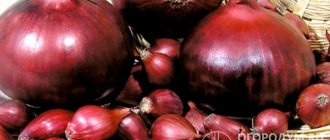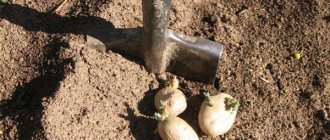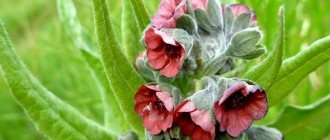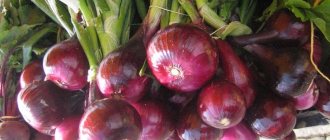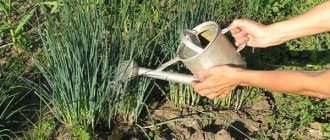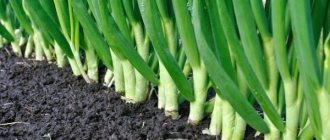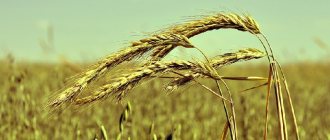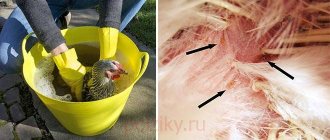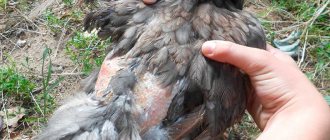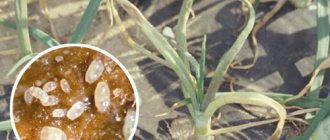Description and characteristics of the Crimean red onion variety
Yalta onion is a salad variety.
Therefore, it will not be stored for a long time, but the stated 4-5 months for storage is quite enough to enjoy its taste. The bulb has a flattened shape. Onion scales are quite thick, can reach 7 mm. The purple or pinkish color turns into a transparent white, with a slight pink tint, on the inside of the bulb. Reference. Onions are characterized by a pronounced sweet taste, with virtually no pungency. These features will help you easily distinguish real Yalta onions from other varieties of red onions.
Growing areas
The growing area of the Yalta onion is in the Crimea, which is quite clear from the name. The most delicious onions grow in:
- in the Simeiz region - the village of Opolznevoye;
- Alushta region - in the villages of Zaprudny, Maly Mayak, Lavrovoe, Kiparisnoye.
These mountainous regions of Crimea have specific climatic conditions. This aspect, plus the mineral characteristics of the soils of these areas, contribute to the cultivation of tender and not sharp onions. This is why Crimeans believe that it is impossible to grow real Yalta onions in other climatic zones.
When is it better to plant in the Crimea, the Black Earth Region, the middle zone, the Moscow region, and the Urals?
Yalta red onions are grown mainly by seedlings. This planting method is practiced not only in the Black Earth Region and the Urals, but also by gardeners in the Crimea. In many climatic zones, the seedling method is the only possible way to obtain onions that are as similar as possible to Yalta onions.
Reference. You should start sowing seeds for seedlings on the 20th of February.
Seedlings are planted directly into the ground in late April - early May. The seedless method leads to a significant reduction in yield. The bulb does not ripen, its shape and taste change.
Some gardeners claim that it is possible to grow Yalta onions not only in Crimea , but also in cooler areas by planting onion sets before winter, when stable frosts have not yet set in; the sets are planted three weeks before. Before frost, plantings must be mulched with hay or straw. There is also a negative point with this method of cultivation - the onion becomes spicy, and onion sets do not tolerate storage very well.
Reproduction
Yalta onions are grown from seeds. They can be purchased in specialized stores or directly from farmers working with this crop. Seeds can be sown directly into the ground. This article will tell you how to grow onions from seeds.
However, if you want to get a good harvest in the first year and harvest it as early as possible, it is recommended to use the seedling method. You can start working with it already in early March, so that by the end of the frosts on the ground, you can plant the seedlings in open soil.
After stratification, the seeds are laid out on a damp surface so that they sprout.
Preparing the bed and soil for planting
By the beginning of October, all soil preparation should be completed. Necessary:
- weed and remove weeds;
- apply fertilizer (preferably organic);
- carry out deep digging of the earth, followed by harrowing.
All this preparatory work will help the soil accumulate moisture over the winter. Before directly planting seedlings in the ground in the spring, the soil must be kept clean and loose. Choose a place for the garden bed where the sun can warm the ground all day. You should abandon the area where melt water stagnates for a long time.
Best predecessors:
- peas;
- beans;
- potato;
- tomatoes.
Do not use a site where other types of onions grew.
How to properly plant seeds for seedlings?
To grow seedlings, you need to prepare seeds and nutrient soil. Proper care of the plant is of great importance.
How to prepare seeds for sowing
Treating seeds with special nutrient solutions helps increase their germination and ensures the appearance of friendly and strong shoots. Soaking in a solution of potassium permanganate disinfects planting material. Keep it there for about four minutes. The color of the solution used is light pink.
After thorough washing, the seed material should be placed in a growth stimulator solution. The dosage and method of use are indicated by the manufacturer in the instructions.
After drying, the seeds are ready for planting.
How to sow?
You can plant seeds this way:
- Preparing trays with nutrient soil. You can buy a ready-made mixture in the store or prepare it yourself. A mixture of turf soil and humus, plus mineral fertilizers, is used. The substrate should fill 15 cm of the tray height.
- Make grooves. Their depth is no more than 1 cm, the distance between the furrows is 4 cm.
- Water the furrows with warm water.
- Sowing seeds. The distance between seeds should be 1 cm. Row spacing should be 4 cm.
- Filling the furrows with an earthen mixture followed by finely dispersed (spray) watering.
Proper planting ensures rapid germination of onions.
Primary care
Caring for crops involves the following manipulations:
- Compliance with pre-emergence temperature conditions. The place where the tray with the sown seeds is located should be well lit. The temperature is maintained at 25 degrees.
- Maintaining the required post-emergence temperature. After the first seedlings appear, the daytime temperature should be reduced to 15 degrees. At night it drops to 10 degrees.
- Provide adequate lighting. At the end of February, daylight hours are still quite short. Additional illumination with phytolamps is required.
- Sufficient and regular watering and fertilizing. The first feeding can be done when the seedlings reach 20 days. Use fertilizers that promote leaf growth and root system formation.
A few weeks before planting seedlings in the ground, they are hardened. They are taken out into the open air during the day and brought indoors at night. These manipulations will allow the seedlings to painlessly transfer the planting to a permanent place in the ground. Before planting seedlings in the ground, stop watering.
The result of following these simple rules is strong seedlings with well-formed leaf apparatus and fibrous roots. Seedlings ready for planting should have 3-4 leaves, about 20 cm high.
Rules of care
Watering
Regular watering is simply necessary. Yalta onions contain a lot of sugar and water; with a lack of moisture, the onions become bitter and pungent.
At the same time, you should not over-water onions, as this provokes the appearance of diseases - downy mildew, various rots.
Stop watering three weeks before harvest. This will allow the bulbs to ripen, plus their keeping quality increases.
Top dressing
Yalta onion, like any other vegetable, needs regular feeding. It is recommended to do them once every 10 days.
- Initial fertilizing is carried out in order to build up the leaf and root systems. These should be nitrogen-containing fertilizers. For example, a solution of cow manure in water (1:5) or chicken manure infused in water in a ratio of 1:10.
- Subsequent feeding is aimed at the formation and filling of the bulbs. Potassium-phosphorus fertilizers are responsible for this. Dilute 40 grams of superphosphate and 20 grams of potassium chloride in ten liters of warm water and add this solution to the onions.
Thermal and light conditions
The presence of sufficient heat and light determines the yield of Yalta onions and its taste characteristics. After all, its homeland is the well-warmed shale soils of the southern coast of Crimea. To grow such onions in central Russia, the Moscow region and other climatic zones, gardeners often have to use greenhouses or greenhouses.
Is pruning and picking necessary?
It is recommended to trim onion feathers and roots before planting seedlings in the ground. This operation should be carried out quickly to prevent the seedlings from drying out. The root is cut off and the top is trimmed to a third of the length. This procedure helps improve seedling survival.
It has been experimentally established that transferring a bulbous sprout with a clod of earth also brings good results. This method is used if the seeds were sown in special cassettes and not in seedling boxes.
Diseases and pests
- Onions are most often affected by downy mildew. This can be avoided by performing preventive treatments with Aliette 80% s. n. or 1% Bordeaux mixture.
- The main pests of onions are thrips and onion fly. To fight them, use Enzhio or Aktara. These chemical plant protection products should be used strictly following the instructions.
What are the benefits of Yalta onion?
Including red vegetables in your diet has a positive effect on your well-being. The mineral and vitamin composition is responsible for the beneficial properties of Yalta onions:
- increasing immunity;
- anti-inflammatory effect;
- prevention of tumor development;
- lowering cholesterol levels;
- removal of toxins;
- improvement of vascular condition;
- increased collagen production;
- blood pressure stabilization;
- fight against parasites.
Traditional healers recommend introducing the red product into your diet to strengthen the central nervous system and forget about insomnia and nervousness. Eating the product has a positive effect on the functioning of the cardiovascular system, brain, and digestive organs.
Harvesting
Usually it takes about 5 months from sowing the seeds to harvesting. Leaves have fallen en masse - it's time to harvest. The onions are removed from the ground very carefully, then dried under a canopy. You should not hesitate to collect. Rainy weather leads to rotting of onions, and accordingly, their shelf life is significantly reduced.
Adhering to the correct technology, about 200 kg of Yalta onions per hundred square meters can be grown using seedlings. Using the seedless method reduces the yield by half.
From planting to harvesting: you will learn all the secrets of growing the best varieties of onions on the pages of our website. Read about these - Shakespeare, fragrant, Sturon, white, chives, Chalcedony, Radar, family, Corrado and Troy.
Application in cosmetology
What is the real Yalta onion famous for? The red product is used for cosmetic purposes. Improves the condition of the skin, helps with dermatological problems. Masks based on Crimean onions for hands and face make the skin softer and restore youth. Onion juice is indispensable for acne. Its use makes age spots invisible. Red onion pulp strengthens hair follicles. To achieve the effect, rub the product into the scalp. After half an hour, the composition is washed off and the hair is thoroughly washed with shampoo.
How are the bulbs stored?
Yalta onions are of salad type, which means they are not suitable for long-term storage. Maximum 4-5 months. The air humidity in the storage should not exceed 50%, the preferred storage temperature is about 15 degrees. It is recommended to braid the onion shoots, so they do not touch each other, are well ventilated and are better preserved.
Growing Yalta onions at home is quite problematic. Especially in climatic zones different from the Crimean ones. A positive result will be achieved only if you adhere to the correct agricultural technology and take into account climatic and other aspects.
Use in cooking
It is preferable to eat Yalta onions fresh. Snacks are prepared from the red vegetable; it is added to side dishes and salads. The bulbs go well with meat, fish, and muscat wine. The following dishes are prepared with the addition of red product:
- shashlik;
- soups;
- baked chicken;
- meatloaf;
- pizza;
- savory baked goods;
- pickled tomatoes.
Diced Crimean onions can be added to stews and savory roasts, or added to a hot dog or burger. The cooked food is juicy and has a pleasant taste. Yalta onions are a tasty choice for people who care about their health. A recipe for Crimean salad is highlighted. Components:
- Crimean onion – 2 pcs.;
- salt, herbs, vegetable oil;
- white cabbage – 350 g;
- bell pepper – 2 pcs.
How to cook:
- Cut the vegetables: red onion into rings, pepper into strips, cabbage into strips.
- Chopping greens.
- Mix the ingredients.
- Salt, season with oil.
The product is a must-have vegetable in the kitchen pantry.
